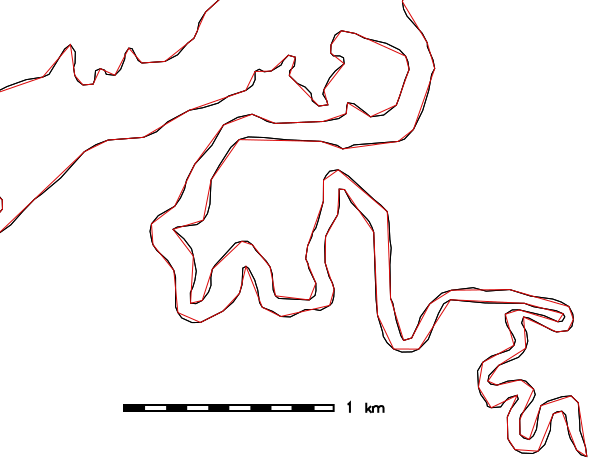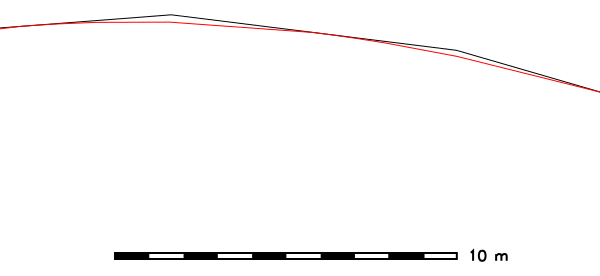DESCRIPTION
v.generalize
is a module for the generalization of GRASS vector maps. This module
consists of algorithms for line simplification, line smoothing,
network generalization and displacement (new methods may be added later).
If type=area is selected, boundaries of selected areas will be
generalized, and the options cats, where, and
layer will be used to select areas.
NOTES
(Line) simplification is a process of reducing the complexity of vector
features. The module transforms a line into another line consisting of
fewer vertices, that still approximate the original line. Most of the
algorithms described below select a subset of points on the original line.
(Line) smoothing is a "reverse" process which takes as input a line and
produces a smoother approximate of the original. In some cases, this is
achieved by inserting new vertices into the original line, and can total
up to 4000% of the number of vertices in the original. In such an instance,
it is always a good idea to simplify the line after smoothing.
Smoothing and simplification algorithms implemented in this module
work line by line, i.e. simplification/smoothing of one line does not
affect the other lines; they are treated separately. For isolated loops
formed by a single line/boundary, he first and the last point of each
line/boundary can be translated and/or deleted, unless the -l
flag is used to disable loop support.
Lines and boundaries are not translated if they would collapse to a
single point. Boundaries are not translated if they would intersect
with themselves or other boundaries. Such erroneous features are written
to an optional error vector map. Overlaying the error
map over the generalized map indicates the kind of error.
Lines/boundaries collapsing to a point are written out as points,
boundaries violating topology are written out as boundaries. The
error map can be overlaid over the generalized map to
understand why some features were not generalized.
SIMPLIFICATION
Simplification can fail for many boundaries if the simplification
parameters would result in a large reduction of vertices. If many
lines/boundaries could not be simplified, try different parameters that
would cause a lower degree of simplification.
v.generalize contains following line simplification algorithms:
- Douglas-Peucker Algorithm
- Douglas-Peucker Reduction Algorithm
- Lang Algorithm
- Vertex Reduction
- Reumann-Witkam Algorithm
- Remove Small Lines/Areas
Different algorithms require different parameters, but all the algorithms
have one parameter in common: the threshold parameter, given in map
units (for latitude-longitude locations: in decimal degree). In general,
the degree of simplification increases with the increasing value of
threshold.
ALGORITHM DESCRIPTIONS
- Douglas-Peucker - "Quicksort" of line simplification, the
most widely used algorithm. Input parameters: input,
threshold. For more information, see:
http://geomalgorithms.com/a16-_decimate-1.html.
- Douglas-Peucker Reduction Algorithm is essentially the same
algorithm as the algorithm above, the difference being that it takes
an additional reduction parameter which denotes the percentage
of the number of points on the new line with respect to the number
of points on the original line. Input parameters: input,
threshold, reduction.
- Lang - Another standard algorithm. Input parameters:
input, threshold, look_ahead.
For an excellent description, see:
http://www.sli.unimelb.edu.au/gisweb/LGmodule/LGLangVisualisation.htm.
- Vertex Reduction - Simplest among the algorithms. Input
parameters: input, threshold.
Given a line, this algorithm removes the points of this line which
are closer to each other than threshold. More precisely, if
p1 and p2 are two consecutive points, and the distance between p2
and p1 is less than threshold, it removes p2 and repeats the
same process on the remaining points.
- Reumann-Witkam - Input parameters: input,
threshold.
This algorithm quite reasonably preserves the global characteristics
of the lines. For more information, see for example:
http://psimpl.sourceforge.net/reumann-witkam.html.
Douglas-Peucker and Douglas-Peucker Reduction Algorithm
use the same method to simplify the lines. Note that
v.generalize input=boundary_county output=boundary_county_dp20 method=douglas threshold=20
v.generalize input=boundary_county output=boundary_county_dp_red20_100 \
method=douglas_reduction threshold=20 reduction=100
v.generalize input=boundary_county output=boundary_county_dp_red0_30 \
method=douglas_reduction threshold=0 reduction=30
SMOOTHING
The following smoothing algorithms are implemented in v.generalize:
- Boyle's Forward-Looking Algorithm - The position of each point
depends on the position of the previous points and the point
look_ahead ahead. look_ahead consecutive points. Input
parameters: input, look_ahead.
- McMaster's Sliding Averaging Algorithm - Input Parameters:
input, slide, look_ahead.
The new position of each point is the average of the look_ahead
points around. Parameter slide is used for linear interpolation
between old and new position (see below).
- McMaster's Distance-Weighting Algorithm - Takes the weighted
average of look_ahead consecutive points where the weight is
the reciprocal of the distance from the point to the currently
smoothed point. The parameter slide is used for linear
interpolation between the original position of the point and newly
computed position where value 0 means the original position.
Input parameters: input, slide, look_ahead.
- Chaiken's Algorithm - "Inscribes" a line touching the original
line such that the points on this new line are at least
threshold apart. Input parameters: input,
threshold. This algorithm approximates the given line very
well.
- Hermite Interpolation - This algorithm takes the points of
the given line as the control points of hermite cubic spline and
approximates this spline by the points approximately
threshold apart. This method has excellent results for small
values of threshold, but in this case it produces a huge
number of new points and some simplification is usually needed.
Input parameters: input, threshold, angle_thresh.
Angle_thresh is used for reducing the number of the points.
It denotes the minimal angle (in degrees) between two consecutive
segments of a line.
- Snakes is the method of minimisation of the "energy" of a
line. This method preserves the general characteristics of the lines
but smooths the "sharp corners" of a line. Input parameters
input, alpha, beta.
This algorithm works very well for small values of alpha and
beta (between 0 and 5). These parameters affect the
"sharpness" and the curvature of the computed line.
One of the key advantages of Hermite Interpolation is the fact
that the computed line always passes through the points of the original
line, whereas the lines produced by the remaining algorithms never pass
through these points. In some sense, this algorithm outputs a line which
"circumscribes" the input line.
On the other hand, Chaiken's Algorithm outputs a line which
"inscribes" a given line. The output line always touches/intersects the
centre of the input line segment between two consecutive points. For
more iterations, the property above does not hold, but the computed
lines are very similar to the Bezier Splines. The disadvantage of the
two algorithms given above is that they increase the number of points.
However, Hermite Interpolation can be used as another
simplification algorithm. To achieve this, it is necessary to set
angle_thresh to higher values (15 or so).
One restriction on both McMasters' Algorithms is that look_ahead
parameter must be odd. Also note that these algorithms have no effect if
look_ahead = 1.
Note that Boyle's, McMasters' and Snakes algorithm
are sometimes used in the signal processing to smooth the signals.
More importantly, these algorithms never change the number of points on
the lines; they only translate the points, and do not insert any new points.
Snakes Algorithm is (asymptotically) the slowest among the
algorithms presented above. Also, it requires quite a lot of memory.
This means that it is not very efficient for maps with the lines
consisting of many segments.
DISPLACEMENT
The displacement is used when the lines overlap and/or are close to each
other at the current level of detail. In general, displacement methods
move the conflicting features apart so that they do not interact and can
be distinguished.
This module implements an algorithm for displacement of linear features
based on the Snakes approach. This method generally yields very
good results; however, it requires a lot of memory and is not very efficient.
Displacement is selected by method=displacement. It uses the
following parameters:
-
threshold - specifies critical distance. Two features interact if
they are closer than threshold apart.
-
alpha, beta - These parameters define the rigidity of lines.
For larger values of alpha, beta (>=1), the algorithm
does a better job at retaining the original shape of the lines, possibly
at the expense of displacement distance. If the values of alpha,
beta are too small (<=0.001), then the lines are moved
sufficiently, but the geometry and topology of lines can be destroyed.
Most likely the best way to find the good values of alpha, beta
is by trial and error.
-
iterations - denotes the number of iterations the interactions
between the lines are resolved. Good starting points for values of
iterations are between 10 and 100.
The lines affected by the algorithm can be specified by the layer,
cats and where parameters.
NETWORK GENERALIZATION
Used for selecting "the most important" part of the network. This is based
on the graph algorithms. Network generalization is applied if method=network.
The algorithm calculates three centrality measures for each line in the
network and only the lines with the values greater than thresholds are selected.
The behaviour of algorithm can be altered by the following parameters:
-
degree_thresh - algorithm selects only the lines which share a point
with at least degree_thresh different lines.
-
closeness_thresh - is always in the range (0, 1]. Only the lines
with the closeness centrality value at least closeness_thresh apart
are selected. The lines in the centre of a network have greater values of
this measure than the lines near the border of a network. This means that
this parameter can be used for selecting the centre(s) of a network. Note
that if closeness_thresh=0 then everything is selected.
-
betweeness_thresh - Again, only the lines with a betweeness
centrality measure at least betweeness_thresh are selected. This
value is always positive and is larger for large networks. It denotes to
what extent a line is in between the other lines in the network. This
value is large for the lines which lie between other lines and lie on
the paths between two parts of a network. In the terminology of road
networks, these are highways, bypasses, main roads/streets, etc.
All three parameters above can be presented at the same time. In that
case, the algorithm selects only the lines which meet each criterion.
Also, the outputed network may not be connected if the value of
betweeness_thresh is too large.
EXAMPLES
SIMPLIFICATION EXAMPLE
Simplification of county boundaries with DP method (North Carolina sample dataset),
threshold given in mapset units (here: meters):
v.generalize input=boundary_county output=boundary_county_dp20 \
method=douglas threshold=20 error=boundary_county_dp20_leftover
 Figure: Vector simplification example (spatial subset:
original map shown in black, simplified map with 26% remaining vertices shown in red)
Figure: Vector simplification example (spatial subset:
original map shown in black, simplified map with 26% remaining vertices shown in red)
SMOOTHING EXAMPLE
Smoothing of road network with Chaiken method (North Carolina sample dataset),
threshold given in mapset units (here: meters):
v.generalize input=roads output=roads_chaiken method=chaiken \
threshold=1 error=roads_chaiken_leftover
 Figure: Vector smoothing example (spatial subset:
original map shown in black, smoothed map with 500% increased number of vertices shown in red)
Figure: Vector smoothing example (spatial subset:
original map shown in black, smoothed map with 500% increased number of vertices shown in red)
SEE ALSO
v.clean,
v.dissolve
v.generalize Tutorial (GRASS-Wiki)
AUTHORS
Daniel Bundala, Google Summer of Code 2007, Student
Wolf Bergenheim, Mentor
Partial rewrite: Markus Metz
Last changed: $Date$


